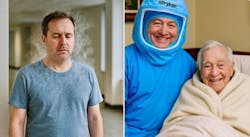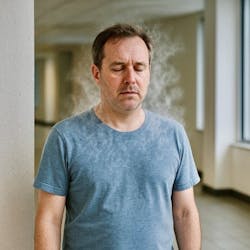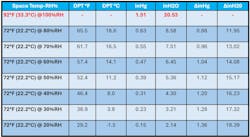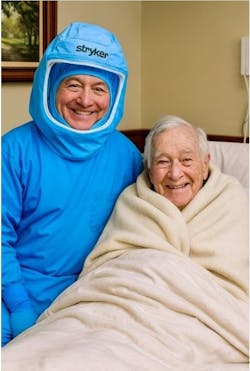Optimizing Physiological Cooling Through Humidity Control
HVACD engineers face the complex task of designing systems that deliver comfort, productivity, and occupant satisfaction across all building types.
This is a formidable task, and one that can be best achieved when certain psychrometric principles are understood and applied. Temperature alone does not guarantee comfort, and it is only through the proper combination of space (sensible) temperature and (latent) humidity control that indoor environments are created that achieve optimized results.
The Human Factor
Warm blooded animals (like us) maintain an internal temperature higher than the ambient temperature surrounding us, so heat flows from our body to the environment. Humans constantly regulate heat through a balance of heat production (metabolism) and heat loss, exchanging heat with the environment in order to regulate temperature. Temperature regulation attempts to maintain core body temperature near 98.6°F (37°C), despite varying conditions and activity levels.
At rest, the body loses heat through conduction (~3%), convection (~27%), radiation (~40%), and evaporation through the skin (~30%). For HVACD engineers, understanding these physiological mechanisms is key to designing spaces that align with how the body actually sheds heat.
The rate at which we deliver metabolic heat outward depends on several factors.
Sensible heat loss from the skin is regulated by the thermal insulating value of clothing, the ambient temperature, and the heat coefficient of air at the skin surface. Evaporative heat loss from the skin depends on the wetness of the skin, the vapor pressure (humidity) in the ambient air, the evaporative heat transfer coefficient, and the vapor permeance of clothing. With mean radiant temperature being another crucial factor, these govern rates of heat loss between the body and the external environment.
If the rate of bodily heat production exceeds that of total heat loss, heat storage occurs, and deep body temperature rises. It must then be dissipated to the external environment to prevent overheating, with heat illness occurring if the body is unable to maintain a balance between heat generation and core body temperature. If taken further, heat stroke happens when core body temperature reaches ~104°F (40°C).
Once environmental temperature rises and heat loss is impaired, sweat evaporation becomes the body’s primary cooling method. Sweat evaporation is the vaporization and subsequent diffusion of moisture from the skin surface, and the thermal energy needed to vaporize sweat (the latent heat of evaporation), is drawn from the skin and therefore cools it.
Values for latent heat of evaporation of human sweat are suggested to be similar to the latent heat of evaporation of pure water, giving a value of ~1,050 Btu/lb (~2,445 kJ/kg) at 72°F (22.2°C). Of the primary heat-loss mechanisms noted, it is the impact that evaporative cooling has on our body that is often overlooked or misunderstood.
The Importance of Humidity Control
While occupants may prefer cooler indoor temperatures for comfort, particularly in the summer, building code and standards (e.g., ASHRAE 55, 62.1, or 170) may dictate humidity conditions for compliance. It is the two, simultaneously, that truly determine how well any indoor environment is received.
Unfortunately, many HVACD systems cannot obtain the combined temperature and humidity that garners environmental success, and a lack of attention to this important psychrometric prerequisite many times results in less than desired results.
While dry-bulb temperature often dominates discussions of comfort, humidity, and more specifically vapor pressure, plays an equally critical role. Vapor pressure is the force exerted by water vapor. It is defined as the pressure at which vapor, and liquid can exist in equilibrium at a given temperature.
In psychrometrics, the value of vapor pressure is calculated from other properties such as humidity ratio or dew-point temperature (absolute moisture). Each water molecule exerts pressure on the surrounding environment. Water vapor diffuses (moves) from high to low vapor pressure and can move independently of airflow.
Simply stated, it is the displacement of molecules of a fluid within another fluid, such as water vapor in air. Measured in inches of mercury (inHg), vapor pressure helps explain sweat evaporation.
When attempting to remove and evaporate sweat from the body, moisture must typically travel through clothing. Perspiration which is driven through clothing must then be exposed to convective air currents which assist in evaporation and its cooling effect.
Evaporative cooling depends on vapor pressure gradients between skin and ambient air, which are strongly influenced by local psychrometric conditions. These conditions determine how quickly any vapor transmission occurs by molecular diffusion and evaporation, and what immediate cooling effect it may have on a building occupant. Without creating space conditions to accomplish this task, people can feel wet, clammy, and too warm regardless of the dry-bulb temperature.
In fact, colder air in a too-humid environment may aggravate an already unpleasant situation. Many times, we do not need cooler ambient air, we need drier ambient air.
Figure 2 shows the vapor pressure gradients between a saturated skin surface at 92°F (33.3°C) and the surrounding air at 72°F dry-bulb (22.2°C), with varying relative humidities. It is evident that lower space vapor pressures can drive higher vapor pressure differentials which assist in moisture diffusion, positively impacting our body’s evaporation efficiency.
As a caveat, while vapor pressure is typically expressed in inHg, inches of water column (inH2O) may be a more intuitive measurement for HVACD professionals who compare it with fan static pressure. This requires multiplying inHg by ~13.60 to achieve a comparable number. Viewed this way, it is immediately recognizable that vapor pressure can create a considerable driving force for moisture in the air.
Engineers should consider designing indoor environments which can achieve the necessary vapor pressure gradients between the occupant’s skin and the surrounding ambient to assist in wicking perspiration quickly, through layers of outer clothing. How large this indoor vapor pressure gradient needs to be is ambiguous, and subjective to seasonal weather conditions, the occupant’s activity level, the amount of outer clothing worn, along with other influencing factors. More industry guidance is needed in this area, but regardless it is important to understand and take into consideration.
As an example, orthopedic surgeons heavily gowned and performing stressfully under high intensity lighting may demand their operating suites be both cold and dry, perhaps conditioned to 60°F DB (15.6°C) at 40% RH and ~36°F (2.2°C) dew-point temperature at 0.20 inHg. Without aggressive dehumidification strategies, these conditions cannot be achieved with conventional cold coil-based cooling systems.
Elderly individuals in senior care facilities may prefer surroundings closer to 78°F (25.6°C) at 50% RH and ~58°F (14.4°C) dew-point at 0.48 inHg to provide warmer temperature with a surrounding humidity that limits the evaporative cooling effect from their body, see Figure 3.
Too high of vapor pressure differential, coupled with cold interior building surfaces, is also a possibility of why people located in wintry northern climates may feel “chilled” even with elevated indoor sensible temperatures when relative humidity drops below ~30% due to drier outdoor conditions. This may create too much evaporative cooling of an occupant’s skin surface.
It also illustrates why a one-size-fits-all approach to humidity control cannot meet the physiological needs of diverse populations. Indoor skin-to-air vapor pressure differentials of 1.12 to 1.20 inHg may be warranted in the summertime, while wintertime differentials of 1.04 to 1.12 inHg may be more favorable.
Optimizing Environmental Results
Existing practices applied in HVACD system design often fail to achieve satisfactory indoor conditions when considering both temperature and humidity. Most systems take a traditional approach to dehumidification which is based on the removal of moisture through condensation.
This occurs when air is chilled below its dew-point temperature through contact with a cold surface such as a cooling coil supplied with refrigerant or chilled water. As warm, humid air passes over the coil’s tubes and fins, its sensible temperature is reduced, and depending on the leaving temperature of the air, latent heat may also be removed through formation of liquid condensate, which lowers the moisture content of the air.
Many systems like this cannot reach a low enough coil temperature to meet psychrometric requirements for comfort based on indoor humidity and the resulting vapor pressure gradients between skin and ambient air which enhances the evaporative cooling effect.
In applications requiring humidity control beyond the limits of cooling coils, solid desiccant dehumidification provides a proven alternative. This technology can remove moisture from the air by means of a desiccant, a substance that “adsorbs” water in its vapor state (molecularly), without requiring moisture to condense on a cold surface.
Solid desiccant dehumidification can easily maintain a space at 60°FDB (15.5°C) and 40% RH for a hospital operating room environment, or garner dew-point temperatures as low as -80°F (-62°F C) for lithium battery manufacturing and other critically stringent applications.
The HVACD Engineer’s Role
The engineer’s role then become one of achieving a balanced design which controls latent loads as aggressively as sensible loads and does not rely solely on space temperature control to produce satisfactory results. Considering dedicated dehumidification strategies (e.g., active solid desiccant, DOAS, applied chilled-water with reheat) to maintain optimal humidity conditions and applicable skin-to-air vapor pressure differentials is imperative. Comfort is not a thermostat setting, it’s a psychrometric balance.
By designing for both temperature and vapor pressure control, engineers can deliver environments that build upon, and go beyond, the guidance of ASHRAE Standard 55 on thermal comfort, truly optimizing human comfort, performance, and well-being.
#####
About the Author
DAVID SCHURK
DES, CEM, LEED AP, CDSM, SFP - Innovative Air Technologies
David N. Schurk, DES, CEM, LEED-AP, CDSM, CWEP, SFP, CIAQM, is the "Dehumidification Jedi" at Innovative Air Technologies in Covington, GA. He is an ASHRAE Distinguished Lecturer and has over 40-years of experience in the design and analysis of heating, ventilating, and air-conditioning systems for a variety of market sectors, with a special focus on aerospace and healthcare facilities. Schurk can be reached at 920-530-7677, or [email protected].



